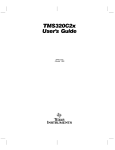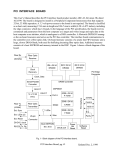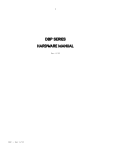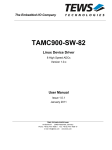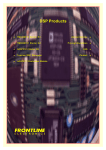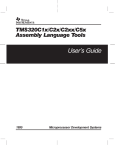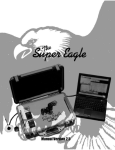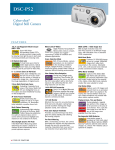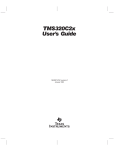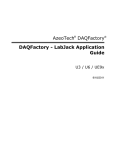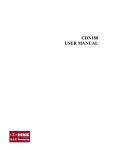Download TIMS-1000 SERIES DSP USER MANUAL
Transcript
TIMS-1000 SERIES DSP USER MANUAL Second Edition Telecommunications Instructional Modeling System TIMS DSP USER MANUAL Issue Number 2.0 June 2000 Published by: Emona Instruments Pty Ltd 86 Parramatta Road Camperdown NSW 2050 Sydney AUSTRALIA COPYRIGHT c 1988,1990, 2000 by EMONA INSTRUMENTS PTY LTD TIMS is a registered trademark of AMBERLEY HOLDINGS PTY LTD Printed in Australia CONTENTS INTRODUCTION 1 SYSTEM CONVENTIONS 2 TIMS-DSP-RB TMS320C10 PROCESSOR BOARD Quick Operating Instructions Detailed Operating Instructions DSP Program/Hardware Interaction Specifications 3 4 4 5 8 TIMS-AIB I/O INTERFACE BOARD FOR DSP-RB Quick Operating Instructions Detailed Operating Instructions Analog & Digital I/O Sampling Clock Generator Sampling Control User Interfaces Specifications 9 10 12 12 13 13 14 15 TIMS-DSP-HS TMS320C50 DEVELOPMENT MODULE Quick Operating Instructions Detailed Operating Information Memory map of the TIMS-DSP-HS External Program Control and Timing Creating EPROM Files Creating Downloadable Files Programming Hints for the New User Specifications 16 17 19 19 20 21 22 23 24 TIMS DSP INTRODUCTION TIMS DSP OVERVIEW TIMS is a modular telecommunications learning system. It models mathematical equations representing electrical signals, or block diagrams representing telecommunications systems. The modules of the basic TIMS system, TIMS 301, are very simple electronic circuits which function as basic communications building blocks, providing signal generation, processing and measurement functions. The TIMS-1000 series enhances the basic TIMS system, with TMS320C50 and TMS320C10 based Digital Signal Processing modules. These modules are designed to interface directly to the traditional electronic modules of the basic TIMS. As well, the TIMS 1000 series DSP modules will emulate the functions of the basic electronic modules or the functions of a series or system of modules. The TMS320C50 based module provides an excellent program development environment while the TMS320C10 based module is ideal for fixed, EPROM-based applications and introduction to DSP demonstrations. Both modules operate in EPROM mode; the TMS320C50 module will run programs from EPROM or RAM. The TMS320C50 module includes all onboard interfaces: analog input and output, digital input and output, user interfaces and serial link to the PC. All I/O for the TMS320C10 module is provided by TIMS AIB, Analog Interface Board. The TIMSAIB has high speed, high resolution Analog to Digital Converters, as well as digital inputs and outputs, and user interfaces. The data and control signals are transferred between the TMS320C10 and TIMS-AIB modules via the back plane bus. TIMS-DSP User Manual 1 SYSTEM CONVENTIONS The TIMS 1000 series modules conform to the same mechanical and electrical conventions as the basic TIMS 301 system. A - FRONT PANEL SOCKETS Signal interconnections are made via front panel, 4mm sockets Sockets on the LEFT HAND SIDE are for signal INPUTS. All inputs are high impedance, typically 56k ohms. Sockets on the RIGHT HAND SIDE are for signal OUTPUTS. All outputs are low impedance, typically 330 ohms. YELLOW sockets are only for ANALOG signals. ANALOG signals are held near the TIMS standard reference level of 4V pk-pk. RED sockets are only for DIGITAL signals. DIGITAL signals are TTL level, 0 to 5 V. GREEN sockets are all common, or system GROUND. Note that input and output impedances are intentionally mismatched, so that signal connections may be made or broken without changing signal amplitudes at module outputs. B - PLUG-IN MODULES Any plug-in modules may be placed in any of the 12 positions of the upper rack. All modules use the back plane bus to obtain power supply : only the TIMS-DSP-RB and AIB modules use the bus to transfer signals. The modules are not locked into position and may need to be held while interconnecting leads are removed. C - LABELING All modules are identified as to the function they perform. Inputs, outputs, controls and switches are labeled so that a student who has had only a brief introduction to TIMS can use the modules without needlessly referring back to the USER MANUAL. D - TIMS 320 MODULE LIST TIMS-DSP-HS TMS320C50-based development module TIMS-1010-RB TMS320C10-based run board TIMS-AIB analog interface board for the TIMS-1010-RB only TIMS-DSP User Manual 2 TIMS-DSP-RB ( TIMS-1010 RUN BOARD ) The TIMS-DSP-RB provides an environment in which DSP programs can easily be tested. Implemented is the T.I. TMS320C10 DSP processor running at 20MHz. Only EPROM configuration is available. DSP PROCESSOR RESET FRONT PANEL TIMS-DSP User Manual 3 QUICK OPERATING INSTRUCTIONS The TMS-DSP-RB module may be installed in any position within the TIMS rack. If other DSP interfacing modules will be used with the processor module, they MUST occupy positions immediately to the RIGHT of the TIMS-DSP-RB. EPROM Operation: the DSP program is run from a programmed EPROM. 1. SELECT MEMORY CONFIGURATION : ensure the EPROMs are installed correctly. 4kW EPROM mode is set when the MEMORY SELect jumpers are all down ( ’B’ position ). No other modes are available on the DSP-RB. 2. PROGRAM EXECUTION : press the RESET push button. DETAILED OPERATING INSTRUCTIONS EPROM Program Selection Jumper J1, located near EPROM U5, is used to select which 4kW block of the 8kW EPROM (2 x 27C64) is available to the TMS320C10 processor. Hence two 4kW programs can be stored in each EPROM pair. Larger, pin-compatible EPROMs may also be used, e.g. 27C128, 27C256, etc. When J1 pins 1 and 2 are jumpered (L), the Low block is selected, i.e. $0000 to $0FFF. If J1 pins 2 and 3 (H) are linked, the EPROMs’ upper 4kW is mapped into the DSP processor’s range. Memory Configuration Always ensure the MEMORY SELect switches all DOWN ( ’B’ position ) The EPROMs take up all the available address space from $000 to $FFF. This configuration suits large fixed programs that only use the TMS320C10’s internal RAM. TIMS-DSP User Manual 4 DSP PROGRAM AND HARDWARE INTERACTION After writing and assembling a DSP program, the program’s operation may be verified using a software simulator. This is particularly useful as the result of each step can be checked under controlled conditions. An alternative approach to debugging software, is to observe the sequence of a small number of key control lines. The relevant control lines will be identified in this section. IC identification: U1 ... TMS320C10, 20MHz DSP processor U2,U3 ... 74HC368, hex buffers, U4 ... 74HC27, 3 input NOR, for decoding Input-Output port addressing U5 ... EPROM 27C64 to 27C256-100ns, High Byte U6 ... EPROM 27C64 to 27C256-100ns, Low Byte U7,U8,U9,U10 ... not used. (Option for RAM, 4k x 16 total) U11 U12 U13 U14 ... ... ... ... 74AC00, 74AC08, 74AC11, 74HC74, 2 input NAND, decoding 2 input AND, decoding 3 input AND, decoding D flip/flop, INTerrupt and BIO synchronization U15,U16 ... 74AC245, bus transceivers U17 ... not used U18 ... SN75155, RS-232 driver TIMS-DSP User Manual 5 Useful Control Lines Memory Control Lines WE .... TMS320 Write Enable. Pin 31; U1. Indicates that valid output data from the TMS320 is available on the data bus. DEN .... TMS320 Data Enable. Pin 32; U1. Indicates that TMS320 is accepting data from the input ports. MEN .... TMS320 Memory Enable. Pin 33; U1. Indicates instruction fetches from program memory. These memory control lines are active low and mutually exclusive. Memory Chip Enable Lines EPROM OE .... Output Enable. Pin 22; U5 and U6. EPROM CE .... Chip Enable. Pin 20; U5 and U6. RAM CE .... Chip Enable. Pin 9; U7,U8,U9 and U10. RAM WE .... Write Enable. Pin 11; U7,U8,U9 and U10. I/O Control Lines IOADD .... Input/Output Address Enable. Pin 12; U13. Active high whenever a port is written to or read from. MWE .... I/O Write Enable. Pin 8; U12. Data is written to an output port when MWE is low and IOADD is high. MDEN .... I/O Data Enable. Pin 6; U12. Data is read from an input port when MDEN is low and IOADD is high. DSP Sampling Rate Control Lines INT .... Interrupt. Pin 5;U1. When a negative going edge is presented to this pin, it causes the TMS320 to service an interrupt. BIO .... Branch on Input Low. Pin 9; U1. If a low signal is presented to this pin when the BIOZ instruction is executed, the TMS320 will branch to the address specified by the instruction. TIMS-DSP User Manual 6 Getting programs into EPROM Two data file management programs are provided on the UTILITIES disk: (i) GENERATING TIMS-ASCII FORMAT FILES EXTRACT.EXE will extract the op-codes from an assembler LIST (*.LST) file and create a data file in TIMS-ASCII format. Once a LIST file has been generated by an assembler, type EXTRACT to run the program, and respond to questions as required. Input: TEXAS TMS32010 assembler LIST (*.LST) file Output: TIMS-ASCII file with *.OPC extension (ii) SPLITTING DATA BYTES FOR EPROM PROGRAMMING ROMEXT.EXE will extract the op-codes from an assembler LIST (*.LST) file and split the data into HIGH and LOW BYTES, ready for EPROM programming. To run the program type ROMEXT, and respond to questions as required. Input: TEXAS TMS32010 assembler LIST (*.LST) file Output: TWO, (industry standard) ASCII HEX format files, compatible with EPROM programmers. One file contains the HIGH BYTES, the other contains the LOW BYTES. User specifies the output file names. TIMS-DSP User Manual 7 SPECIFICATIONS DSP processor : Texas Instruments TMS320C10NL DSP clock rate : 20MHz, crystal Memory configurations : MEM1 .. 2k x 16 EPROM, 2k x 16 RAM (not used) MEM2 .. 4k x 16 EPROM (standard) MEM3 .. 4k x 16 RAM (not used) Interface bus : 32 pin, single row, Eurocard format Pin assignments 1 2 3 4 5 6 7 GND GND GND -15V -15V +15V +15V 8 D0 9 D1 10 D2 11 D3 12 D4 13 D5 14 D6 15 D7 16 D8 17 18 19 20 21 22 23 D9 D10 D11 D12 D13 D14 D15 24 25 26 27 28 29 30 31 32 A0 A1 A2 IOADD MWE MDEN CLK BIO INT TIMS-DSP User Manual 8 TIMS-AIB ( TIMS-1100 ANALOG INTERFACE BOARD ) The TIMS-AIB provides a variety of support facilities for the TIMS-DSP-RB processor board, as well as access to real-world signals through analog or digital interfaces: Analog Interfaces : 1 x input, 2 x outputs Digital Interfaces : 3 x inputs, 3 x outputs, 1 x Interrupt, 1 x BIO Sample Clock Generator : 1.6usec to 408usec, with 1.6usec resolution. User Interfaces : 1 x 3 position toggle switch, software readable; 1 x LED, software controllable. LED DISPLAY 3 POSITION SWITCH TMS320C10 BIO TMS320C10 INTERRUPT TTL INPUTS TTL OUTPUTS ANALOG OUTPUTS ANALOG INPUT FRONT PANEL TIMS-DSP User Manual 9 QUICK OPERATING INSTRUCTIONS Install the TIMS-AIB board immediately to the right of the TIMS- DSP-RB processor board. All data and control signals will thus be transferred via the back plane bus. 1. SAMPLE CLOCK SELECTION : set J1 for internal or external INTerrupt or BIO. If required internally, INT or BIO use the on-board SAMCLOCK (sample clock). Alternatively, external INT or BIO signals may be applied via the front panel sockets. J1 pins are labeled as follows: 2. SAMPLE CLOCK SETTING : if an internal sample clock is being used then select the required sample clock rate at SAM CLOCK dip switch. Note that bit 1 is the lsb and bit 8 is msb, with ON = 1. The switch setting is read in binary, and called the SAMRATE. The resulting clock rate is: SAMCLOCK (Hz) = 1/(SAMRATE x 1.6usec) e.g.. If the required SAMCLOCK is 125kHz, then SAMRATE = 5 = 0101, therefore, the switch would be set NOTE that an INPUT instruction, reading from any input port, MUST be performed after each triggering of an internal INT or BIO, to reset the SAMCLOCK flip/flop. The SAMCLK frequency is independent of this resetting action. 3. I/O ADDRESSING : data can only be written to and read from I/O devices using the port address command. Below is the TIMS-AIB port address map. TIMS-DSP User Manual 10 The analog inputs and outputs only utilize the lower 12 bits. The digital bits are subdivided as follows: Data output of the three position toggle switch: TIMS-DSP User Manual 11 DETAILED OPERATING INSTRUCTIONS Interfaces (i) Analog to Digital Converter Analog to digital conversion is carried out by a single channel 12 bit ADC. The conversion rate is either 10usec or 3us, depending upon the device installed: AD7572AJN10 is 10usec, AD7572AJN03 is 3usec. The input is bipolar and has a maximum signal swing of +/-2.5V: this signal level should not be exceeded. Output code to the ADC is offset binary; i.e. 0000 0000 0000 represents -2.5V and 1111 1111 1111 represents +2.5V. A 3usec sample-and-hold works in conjunction with the ADC; its operation is transparent to the user. It is important to note that no anti-aliasing filter is provided at the ADC input. This is so that the effects of aliasing may be observed directly. If required the TIMS Tunable LPF may be used as an anti-aliasing filter. The ADC output is read by the TMS320 using the INPUT command, addressed to port 0. (ii) Digital to Analog Converter A dual channel CMOS digital to analog converter is provided. Resolution of each channel is 12 bits; the outputs are bipolar using offset binary coding. No reconstruction filtering is provided at the DAC outputs, therefore the stepped outputs from the DACs may be observed directly. If required, the TIMS Tunable LPF may be used for signal reconstruction. The DACs can be written to by the TMS320 using the OUTPUT command, addressed to port 0 for DAC 1 and port 1 for DAC 2. (iii) Digital Inputs Three digital, TTL level inputs can be read by the TMS320 using the INPUT command, addressed to port 3. Data bits 2 to 4 correspond to DIGITAL INPUTS 1 to 3 respectively. (iv) Digital Outputs Three digital, TTL level outputs can be written to by the TMS320 using the OUTPUT command, addressed to port 3. Data bits 1 to 3 correspond to DIGITAL OUTPUTS 1 to 3 respectively. TIMS-DSP User Manual 12 Sample Clock Generator The sample clock, SAMCLK, can be used to provide a regular signal via INTerrupt or BIO, to which the TMS320 can sample input ports or write to output ports. The SAMCLK is derived from the TMS320’s own clock, so ADC operations are synchronized with the processor. An 8 bit dip switch, marked SAMCLK, determines the sampling clock rate, in the following manner: SAMCLK (Hz) = 1/(SAMRATE x 1.6usec) where, SAMRATE is a number from 1 to 255, according to the dip switch. The dip switch should be read RIGHT to LEFT (msb to lsb), where ON = 1 and OFF = 0. All available 255 clock rates can be calculated from the following chart. The SAMCLOCK allows the user to fine tune the sampling period, to within 1.6usec of the program’s maximum execution time. Sampling Control INTerrupt or BIO are used to provide a regular sampling signal to the TMS320. The sources of these two signals may be either internal (i.e. on-board) or external. If they are external then the signals are applied via the TIMS-AIB front panel inputs. If the sources are internal, using the SAMCLOCK, then jumper J1 is used to direct the SAMCLOCK output to either INTerrupt or BIO. This SAMCLOCK signal can be observed via the front panel INT and BIO terminals. TIMS-DSP User Manual 13 IMPORTANT If the SAMCLOCK is used internally, then a read (i.e. INPUT instruction) from any port MUST be performed in software after each INT or BIO call. This will reset the SAMCLOCK flip/flop and enable it to retrigger for the next sampling event. The SAMCLOCK frequency is completely independent of this resetting action. In most applications, the reason for an interrupt , say, is to read new data from an input port, and thus additional instructions are not required to perform this reset. User Interfaces The user interfaces allow interaction between the program and humans. (i) Input Device A toggle switch is used either as a three position function selecting switch, or as a variable control - acting like a ’software potentiometer’ - with the center position being ’normal’. The toggle switches’ contacts can be read by the TMS320 using the input command, addressed to port 3. Data bits 0 and 1 indicate the switch status as follows, (ii) Output Device An LED provides visual output. It can be written to using the output command, addressed to port 3, data bit 0. When data bit 0 is high, the LED will be lit. TIMS-DSP User Manual 14 SPECIFICATIONS Analog Interfaces : Input - AD7572 single channel, 12bit, CMOS, successive approximation; conversion rate AD7572AJN10, 10usec; AD7572AJN03, 3usec; sample-and-hold time, 3usec; Bipolar output, +/-2.5V; offset binary. Output - AD7547JN dual channel, 12 bit, CMOS; Bipolar output, +/-2.5V; offset binary. Digital Interfaces : Input - 3 x TTL level. Output - 3 x TTL level. Special - 1 x INTerrupt, TTL level, input/output; 1 x BIO, TTL level, input/output. Sample Clock Generator : 1.6usec to 408usec, with 1.6usec resolution. User Interfaces : Input - 3 position toggle switch; Output - single LED. TIMS-DSP User Manual 15 TIMS-DSP-HS ( TIMS-1050 DSP DEVELOPMENT MODULE ) The TIMS-DSP-HS provides a DSP program development environment for the TMS320C50 processor. The module includes a variety of analog, digital and user inputs and outputs. DSP programs may be entered by either inserting preprogrammed EPROMs, or by downloading the program into RAM via the serial RS-232 interface. The DSP processor also takes care of the serial communications with the host computer, as well as basic monitor functions. 3 POSITION SWITCH ON THE LEFT RS-232 PC INTERFACE RED LED ON THE RIGHT RED DIGITAL INPUTS 1, 2 & 3 ON THE LEFT HARDWARE RESET TO THE DSP PROCESSOR RED DIGITAL OUTPUTS 1, 2 & 3 ON THE RIGHT YELLOW ANALOG INPUTS ADC 1, 2 & 3 ON THE LEFT RED "XBIO" INPUT RED INTERRUPT INPUT YELLOW ANALOG OUTPUTS DAC 1, 2 & 3 ON THE RIGHT FRONT PANEL TIMS-DSP-HS utilizes the TMS320C50, industry standard fixed point DSP, with 50ns instruction cycle time with 32k word program memory and 32k word data memory. The TIMS-DSP-HS module includes three TIMS-level analog inputs and outputs, three TTL-level digital inputs and outputs, a three position user readable switch and a programmable LED. Note: the similarity between the labeling of the TIMS-AIB module’s inputs and outputs and the TIMS-DSP-HS module’s inputs and outputs. Application programs supplied by Emona for the TIMS-DSP-RB/TIMS-AIB and the TIMS-DSP-HS, such as the CONVOLUTIONAL and TCM DECODER, are written to use inputs and outputs with the same labels. For example, if OUT1 is programmed to provide a TCM bit clock on the TIMS-AIB module, then the TIMS-DSP-HS module’s OUT1 will also provide a bit clock when running the matching TCM application program on the TIMS-DSP-HS. The TIMS-DSP-HS utilizes and enhances the capabilities of the Texas Instruments TMS320C5x DSK. The DSK is a daughter board to the TIMS-DSP-HS and provides an easy to use debugger environment for communicating with a PC via the front panel serial interface. Do not connect any signals to the DSK board’s RCA or 9-pin D connectors. ALL DSK SIGNALS ARE AVAILABLE AT THE FRONT PANEL OF THE TIMS-DSP-HS MODULE. Note: The T.I. TMS320C5x DSK is supplied fully installed and tested on the TIMS-DSP-HS. All original manuals and disks supplied by T.I. with the DSK are included with the TIMS-DSP-HS package. TIMS-DSP User Manual 16 QUICK OPERATING INSTRUCTIONS The TIMS-DSP-HS module may be installed in any position within the TIMS rack. A - EPROM Operation DSP program is run from a programmed EPROM. 1. SELECT EPROM OPERATING MODE: locate jumper J2. It is at the rear of the large circuit board, near L3 and U22. Position the jumper in the EXT position (top two pins shorted). Jumper J2 allows two operating modes to be selected: EXTernal (run program from EXTernal EPROM) and INTernal (run program in RAM and use INTernal Debugger Monitor). Locate jumper J3. It is near the front of the large circuit board. Ensure the jumper is set in the LO position. (This is a user readable jumper which can be used, for example, to select which application to run when the EPROM or RAM has had two applications programmed at different address locations.) 2. INSTALL EPROM: install a preprogrammed EPROM, e.g. the LPF10.HS low pass filter program, into socket U24 on the large circuit board. Take care to ensure the correct orientation. (The EPROM’s pin 1 should be near the label U24). 3. PROGRAM EXECUTION: plug the TIMS-DSP-HS into any position within the TIMS rack. Press the front panel RESET push button. Connect and view the signals as appropriate. For example, if running the LPF10.HS program, patch the AUDIO OSCILLATOR sine output to ADC 1 and view the outputs signals as DAC 1 and DAC 2. B - Download Operation DSP program code is downloaded from a host computer into RAM. 1. SELECT RAM OPERATING MODE: locate jumper J2. It is at the rear of the large circuit board, near L3 and U22. Position the jumper in the INT position (lower two pins shorted). Jumper J2 allows two operating modes to be selected: EXTernal (run program from EXTernal EPROM) and INTernal (run program in RAM and use INTernal Debugger Monitor). Locate jumper J3. It is near the front of the large circuit board. Ensure the jumper is set in the LO position. (This is a user readable jumper, which can be used, for example, to select which application to run when the EPROM or RAM has had two applications programmed at different address locations.) 2. CONNECT SERIAL LINK: plug the TIMS-DSP-HS into any position within the TIMS rack. Plug one end of the serial cable to the SERIAL LINK front panel connector and the other end into the host computer’s serial communications port. 3. RUN THE MONITOR PROGRAM: run the latest version of the T.I. debug monitor program. A copy (for example, file name DSK5d103.exe for version 1.03) is located on the original T.I. floppy disk supplied with the original DSK manuals box. TIMS-DSP User Manual 17 As soon as the monitor establishes communications with the TIMS-DSP-HS, the Debugger Monitor windows will open showing processor information. If communication is not established, then follow the on-screen instructions for port and baud rate setting, using the keyboard arrow keys. 4. PROGRAM DOWNLOAD: (i) type L for load, to select program download; (ii) type C for COFF (Common Object File Format) file format, which has an "*.out" extension; (iii) type the filename, e.g. lpf10c.out; (iv) type N to select download and verify; (v) when download is completed, hit the SPACE BAR key to return to the monitor main menu. 5. PROGRAM EXECUTION: (i) type X to select the execute menu; (ii) type G for go, to start the program running. Connect and view the signals as appropriate. For example, if running the lpf10.out low pass filter program, patch the AUDIO OSCILLATOR sine output to ADC 1 and view the outputs signals as DAC 1 and DAC 2. Note: to reset the processor, use the Debugger’s keyboard commands: do not use the front panel RESET push button. The front panel RESET push button is only used in EPROM mode. TIMS-DSP User Manual 18 DETAILED OPERATING INFORMATION Programs can be executed by downloading from a PC to the onboard Program memory RAM and run via the Debugger interface window. Stand-alone operation, without connection to a PC, is also possible by running the program out of a user programmed and installed EPROM. EPROM mode is useful for running programs once they have been developed and completed. The two operating modes are selected via a single jumper, J2, with two positions being INTernal (run the program in RAM and use the INTernal Debugger Monitor) or EXTernal (run the program EXTernal EPROM). Use of the debugger is discussed in detail in the TMS320C5x DSP Starter Kit Users Guide which is supplied. Creation of the EPROM is discussed later in this manual. Memory map of the TIMS-DSP-HS The 320C50 has 9K of full speed internal memory which can be configured to be either program memory or data memory. (Refer to Chapter 8 of Users Guide). In addition to this the TIMS-DSP-HS provides the following: 32K-word PROGRAM memory space in RAM from 8000h to FFFFh, and 32K-word DATA memory space in RAM from 8000h to FFFFh. The following TIMS-DSP-HS module I/O devices are mapped into the TMS320C50’s I/O space and data space, and are addressable as listed below. NOTE: There is a ’hole’ in data space at addresses 0050h to 0053h, which allows these I/O devices to be addressed with data manipulation instructions and to be observable with the debugger. The debugger does not support I/O space. INPUTS 0050h: ADC 1 (12 bit, 10us conversion time) 0051h: not used 0052h: not used 0053h: DIGITAL IN 1, 2, 3, USER Switch, XBIO and J3. 0053h bit: INPUT: 7 J3 6 - 5 * BIO (XBIO) 4 INPUT 3 3 INPUT 2 2 INPUT 1 1 SW 0 SW It is important to note that no anti-aliasing filter is provided at the ADC 1 input. This is so that the effects of aliasing may be observed directly. If required the TIMS Tuneable LPF may be used as an anti-aliasing filter. * Please refer to the description of how BIO is implemented on the following page. OUTPUTS 0050h: DAC 1 (12 bit) 0051h: DAC 2 (12 bit) 0052h: not used 0053h: DIGITAL OUT 1, 2, 3 and LED TIMS-DSP User Manual 19 0053h bit: OUTPUT: 7 - 6 - 5 - 4 - 3 OUTPUT 3 2 OUTPUT 2 1 OUTPUT 1 0 LED No reconstruction filtering is provided at the DAC 1 & DAC 2 outputs, therefore the stepped outputs from the DACs may be observed directly. If required, the TIMS Tuneable LPF may be used for signal reconstruction. ADC 2, ADC 3 and DAC 3 are supported by the onboard TLC32040 AIC (analog interface circuit) device and are controlled via the programming of specified control registers. They are all 14 bit converters, with a maximum sample rate of 19,200 samples per second. ADC 2 & ADC 3 include switched capacitor antialiasing filters and DAC 3 includes a switched capacitor reconstruction filter. The original AIC data sheet is provided with the other DSK Starter Kit manuals. External Program Control and Timing Two common ways of controlling program timing externally are via the BIO and INT functions of the TMS320C50. INT The front panel INT terminal connects, via buffering, to INT1 (Interrupt 1) of the processor. BIO (XBIO) The processor’s true BIO pin is not available to the user as it is used by the DSK debugger. This means that BIO based instructions cannot be used. As BIO is a level sensitive input, the TIMS-DSP-HS provides an alternative BIO input for the user, known as "XBIO". The front panel terminal labeled BIO actually connects to bit 5 of input address 0053h and can be polled to provide a level sensitive input (in the same way as digital inputs IN 1, 2, 3). This front panel BIO is actually the TIMS-DSP-HS module’s "XBIO". BIO to INT2 If a second external interrupt is required, it is possible to connect the front panel terminal labeled BIO to the processor’s INT2 pin. This is done by jumping positions A and B on the header J1, on the large circuit board. NOTE: do not jumper any other combination of pins A, B C or D, as this may disrupt the TIMSDSP-HS module’s operation. J3 on the large PCB Jumper J3 is a user readable jumper which is connected to data bit 7 of input address 0053h. It has 2 settings: HI and LO which correspond to the TTL signal level of that pin. This jumper is useful as another user setting for program control. As it is not on the front panel, it will not be accidentally modified during front panel operation. J3 can be used, for example, to select which application to run when the EPROM or RAM has two applications programmed at different address locations. Software Timer Interrupts The internal Timer is available to generate periodic CPU interrupts. This function is in addition to the normal functions of the DSK daughter board. (Refer to Section 9.3, page 9-9 of User Guide for details.) TIMS-DSP User Manual 20 CREATING EPROM FILES The following lists the procedure on how to create an EPROM for running programs on the TIMS-DSP-HS. The TMS320C50 has a Boot Loader mode which, upon reset, will load a program from an external EPROM into its internal memory space and then execute that program. This Boot Loader mode is discussed in detail in the TMS320C5x User Guide - see Section 8.8, page 8-32. The mode which is used for the TIMS-DSP-HS is the 8-bit parallel EPROM mode see Section 8.8.3 The EPROM is programmed from an Intel Hex file (filename.i0) which is created by the Hex Conversion Utility program (dsphex.exe) provided with the Texas Instruments COFF Assembly Language Tools, from a COFF object file. Its use is discussed in the TMS320C5x Assembly Language Tools Users Guide - see Section 11, page 11.1 The COFF (Common Object File Format) object file is an industry standard file format, created by a COFF assembler and linker, which is also provided within the above mentioned tools. Steps to create a boot EPROM for the TIMS-DSP-HS : Creating a boot EPROM allows you to run your program from an EPROM installed in the TIMSDSP-HS, without the use of a PC. 1) Take an executable COFF file, e.g. lpf10c.out, and create a Boot Loader Command file, e.g. lpfboot.cmd . This file selects an Intel Hex format. 2) Open an MS-DOS prompt window and run the application dsphex lpfboot to create lpf10c.i0, an Intel Hex file. This Intel Hex file can be programmed into a 32k EPROM and plugged into the TIMS-DSP-HS module. (Larger pin compatible EPROMs may also be used.) Once the Intel Hex file is loaded into the EPROM programmer, manually set the last location (7fffh) to 81h. This location is read by the TMS320C50 processor upon reset to determine which boot loader mode to use. See Section 8.8 of TMS320C5x Users Guide for details. 3) Insert the programmed EPROM into the 28 pin socket labeled U24 and set jumper J2 to EXT. 4) Upon RESET the processor will load the application program from this EPROM into its internal program memory and execute. TIMS-DSP User Manual 21 CREATING DOWNLOADABLE FILES FOR RAM OPERATION The following lists how to use the COFF Assembler to create files that can be downloaded and run in the TIMS-DSP-HS module’s RAM. 1) Create a file using the protocol outlined in the TMS320C5x Assembly Language Tools:User Guide. This Guide is provided with the COFF Assembler. For example the low pass filter program, lpf10c.asm, as well as its Linker Command file, lpf10c.cmd 2) Open the MS-DOS Prompt window and invoke the COFF Assembler as follows: dspa lpf10c -l -v50 -x This will create an Object File, e.g. lpf10c.obj, and a List File, e.g. lpf10c.lst 3) Within an MS-DOS Prompt window, invoke the Linker as follows: dsplnk lpf10c.cmd This will create an executable COFF file and a Map file. 4) Run the DSK debugger, dsk5d103.exe, and load the "*.out" file as follows: From the menu select: Load, Coff, and enter the filename, e.g. lpf10c.out; When loading is complete, to run select: eXecute, Go The debugger will run the loaded program from its start address, e.g. 0a00h. The program operation can now be observed via the front panel of the TIMS-DSP-HS module. Refer to the COFF assembler User Guide for further options. The DSK menu is explained in detail in the TMS320C5x DSP Starter Kit. NOTE: the T.I. COFF Assembler is available separately from Texas Instruments and is not included as standard with the TIMS-DSP-HS module. TIMS-DSP User Manual 22 PROGRAMMING HINTS FOR THE NEW USER - When using internal RAM make sure that the PMST register enables the SARAM to either data or program space with no conflict and as you have intended. - Remember to set the DP pointer to the correct location for your variables. It is easy to forget to set the DP correctly. - When running programs from the debugger, beware that flags etc are not initialized to the hardware reset value in the data book but are set to values used by the debugger. To avoid errors it is good practice to initialize all relevant flags from within your program. - Beware of the peculiar syntax of the BIT instructions. When referring to a particular bit you must enter the ’bit code’ into the instruction rather than the bit number e.g. to test the lsb (bit 0) of location 53h, the instruction is BIT 0053h,0Fh. This is easily overlooked. - Remember that the AIC inputs (ADC 2 & 3) and output (DAC 3) operate with 2’s complement notation whereas ADC 1 and DAC 1 and DAC 2 use offset binary notation (where -2V=0000h and +2V=FFFFh). - BEWARE OF PIPELINE CONFLICTS !!! YOU MUST READ CHAPTER 7, ESPECIALLY SECTIONS 7.2. & 7.2.3 if using ARs. You need to take care after SAMM and LAMM instructions. A simple, though heavy-handed solution is to put 2 NOPs after each SAMM or LAMM. A pipeline conflict will give unexpected values showing up in your registers. - TMS325C50 Application Files Visit the Texas Instruments DSP web site to view a large range of application programs written for the DSK. TIMS-DSP User Manual 23 SPECIFICATIONS DSP processor: Texas Instruments TMS320C50 DSP instruction cycle: 50ns Memory configurations: RAM: 64kW, with 32kW Program space and 32kW Data space; EPROM: 32kW space, 28 pin socket. Communications Port: RS-232, 4 lines. Analog Interfaces: INPUT 1 - AD7572 single channel, 12bit, CMOS, successive approximation; conversion rate AD7572AJN10, 10usec; AD7572AJN03, 3usec; Bipolar input, +/-2.5V; offset binary output; no antialiasing filter provided. INPUT 2 & 3 - TLC32040 AIC, 14bit, CMOS, conversion rate 19,200 samples per second, Bipolar input, 2’s compliment output; Switched capacitor antialiasing input filters provided. OUTPUT 1 & 2 - AD7547JN dual channel, 12 bit, CMOS; Bipolar output, +/-2.5V; offset binary; no reconstruction filters provided. OUTPUT 3 - TLC32040 AIC, 14bit, CMOS, Bipolar output, 2’s compliment input; Switched capacitor reconstruction output filter provided. Digital Interfaces : INPUT 1, 2 & 3 - 3 x TTL level; OUTPUT 1, 2 & 3 - 3 x TTL level; INT - 1 x interrupt to processor’s INT1, TTL level; BIO - 1 x "XBIO", TTL level; with access to processor’s INT2; Sample Clock Generator : Internal, software programmable. User Interfaces : Input - 3 position toggle switch; Output - single LED. TIMS-DSP User Manual 24





























